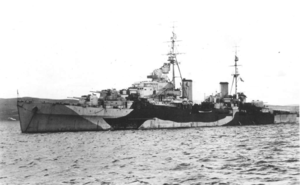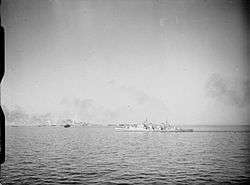HMS Spartan (95)
 HMS Spartan newly completed off Barrow-in-Furness, UK August 1943 | |
| History | |
|---|---|
| Name: | HMS Spartan |
| Builder: | Vickers-Armstrongs, (Barrow-in-Furness, UK) |
| Laid down: | 21 December 1939 |
| Launched: | 27 August 1942 |
| Commissioned: | 12 July 1943[note 1] |
| Fate: | Sunk 29 January 1944 by a Henschel Hs 293 from a German aircraft off Anzio, western Italy. |
| General characteristics | |
| Class and type: | Dido-class light cruiser |
| Displacement: |
|
| Length: | |
| Beam: | 50 ft 6 in (15.39 m) |
| Draught: | 14 ft (4.3 m) |
| Installed power: | 62,000 shp (46,000 kW) |
| Propulsion: |
|
| Speed: | 32.25 kn (37.11 mph; 59.73 km/h) |
| Range: |
|
| Capacity: | 1,100 tons fuel oil |
| Complement: | 530 |
| Armament: | 8 × 5.25 in (133 mm) dual purpose guns (4x2), 12 × 2-pounder anti-aircraft guns (3x4), 12 × 20 mm anti-aircraft cannons (6x2), 6 × 21 in (530 mm) torpedo tubes (2x3) |
| Armour: | |
| Notes: | Pennant number 95 |
HMS Spartan was a Dido-class light cruiser of the Bellona subgroup of the Royal Navy. She was a modified Dido design with only four turrets but improved anti-aircraft armament - also known as Dido Group 2. She was built by Vickers-Armstrongs (Barrow-in-Furness, UK), with the keel being laid down on 21 December 1939. She was launched on 27 August 1942, and commissioned on 12 July 1943.
History
Commissioned with a Devonport crew under the command of Captain P.V. McLaughlin, Royal Navy, Spartan was originally intended for service with the Eastern Fleet, but after a couple of months with the Home Fleet, spent mainly working-up at Scapa Flow, on 17 October 1943 she left Plymouth Sound for the Mediterranean, sailing by way of Gibraltar and Algiers, she arrived at Malta on 28 October 1943 to be temporarily attached to the Mediterranean Fleet. She went on to Taranto to join the 15th Cruiser Squadron on 8 November.
On the night of 18–19 January 1944 Spartan carried out a diversionary bombardment in the Terracina area, and—with the cruiser Orion and four destroyers—provided useful supporting fire during the Garigliano River Operations. There was only minor opposition from shore batteries, and during the bombardment Spartan alone fired 900 rounds.
Operation Shingle—the landing of troops at Anzio—began on 22 January 1944, and Orion and Spartan were detailed to provide gun support. There was little opposition, and Spartan returned to Naples to remain available at short notice.

On 27 January she was ordered to report to CTF 81 for anti-aircraft protection duties off Anzio. At sunset on 29 January the Luftwaffe began a glide bomb attack on the ships in Anzio Bay. At the time of the attack Spartan was anchored. Smoke had been ordered in the anchorage but was not fully effective owing to the short time it was in operation and the strong breeze. Spartan was making smoke from stem to stern but was not herself covered.
About 18 aircraft approached from the north and circling over land, delivered a beam attack against the ships that were silhouetted against the afterglow. Due to the timing of the attack the aircraft were seen only by very few, and radar was ineffective owing to land echoes.
By the time the warning had been received and the ships had opened fire in the general direction of the attack, six bombs were already approaching the anchorage, most of them falling into the water. But at about 18:00 a radio-controlled Henschel Hs 293 bomb hit Spartan just abaft the after funnel and detonated high up in the compartments abreast the port side of the after boiler room, blowing a large hole in the upper deck.
The main mast collapsed and boiler rooms were flooded. Steam and electrical power failed, a serious fire developed and the ship heeled over to port. About an hour after being hit, Spartan had to be abandoned, and 10 minutes later she settled on her beam ends in about 25–30 ft (7.6–9.1 m) of water.
Five officers and 41 enlisted men were posted killed or missing presumed killed, and 42 enlisted men were wounded.
Notes
- ↑ From ship's official log at the National Archives
References
- Colledge, J. J.; Warlow, Ben (2006) [1969]. Ships of the Royal Navy: The Complete Record of all Fighting Ships of the Royal Navy (Rev. ed.). London: Chatham Publishing. ISBN 978-1-86176-281-8. OCLC 67375475.
- WWII cruisers
- HMS Spartan at Uboat.net
- A history of HMS Spartan
External links
| Wikimedia Commons has media related to HMS Spartan (95). |
Coordinates: 41°26′2″N 12°41′2″E / 41.43389°N 12.68389°E